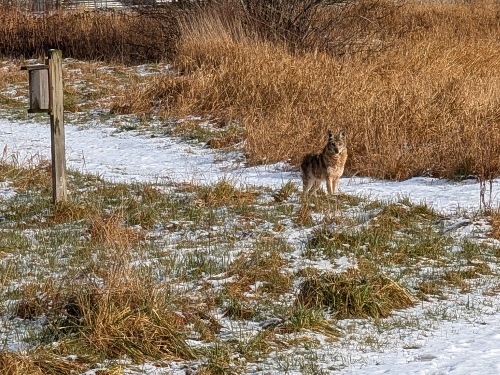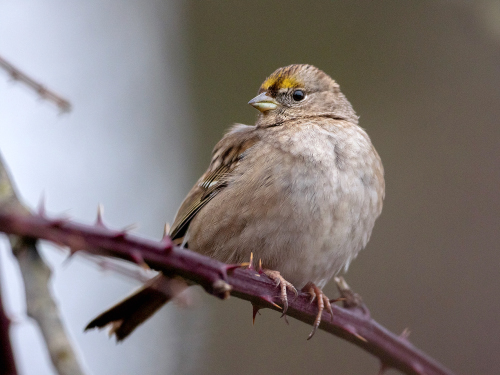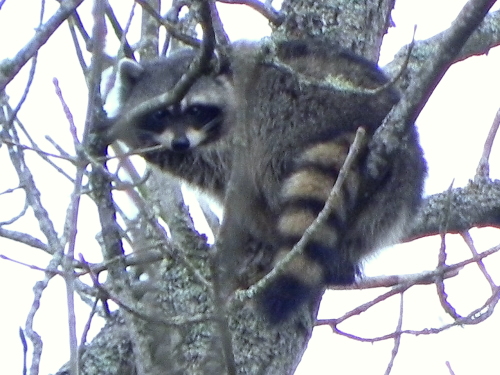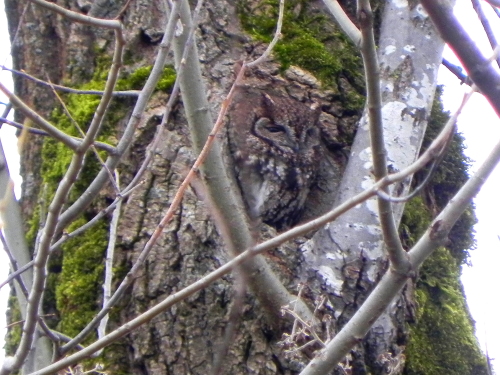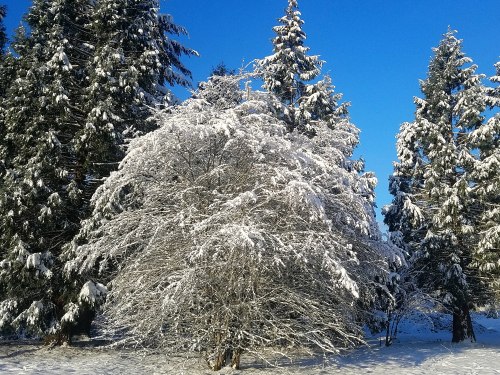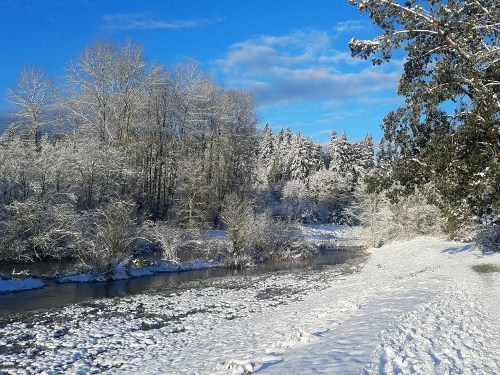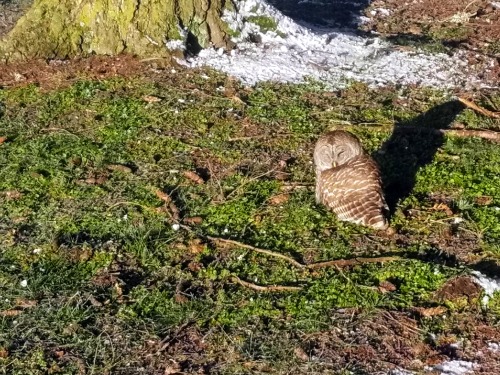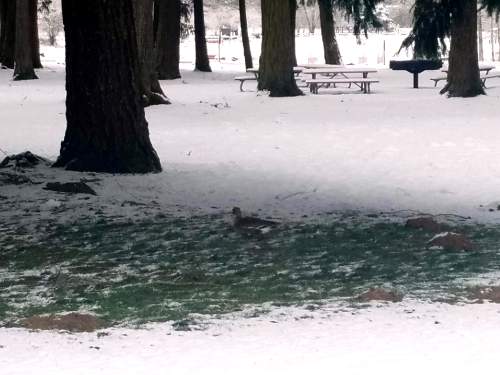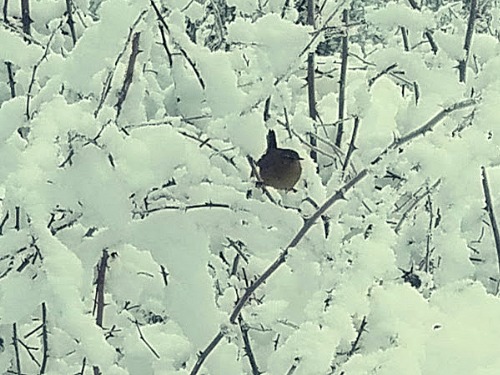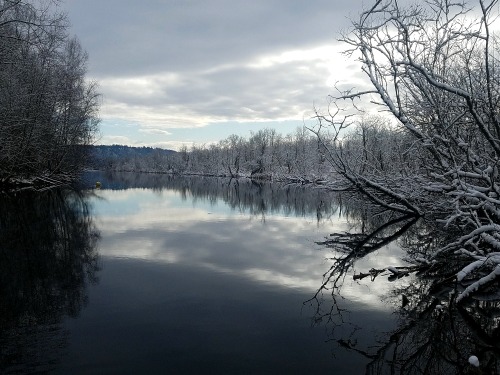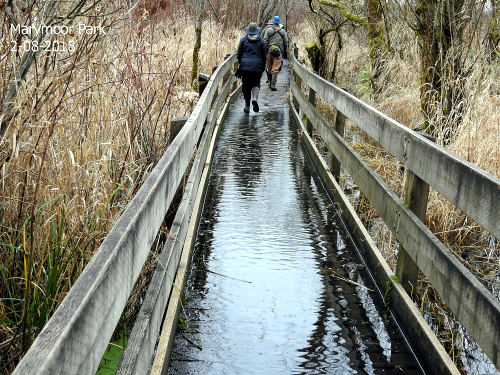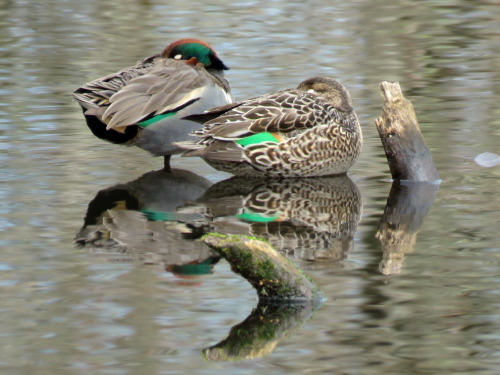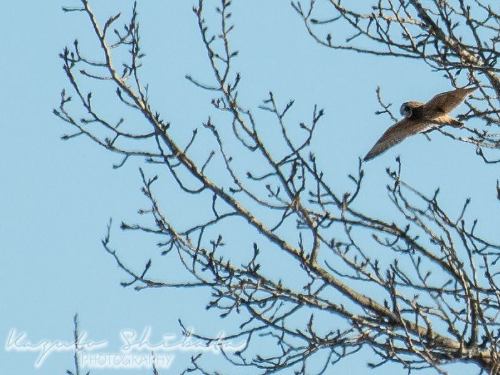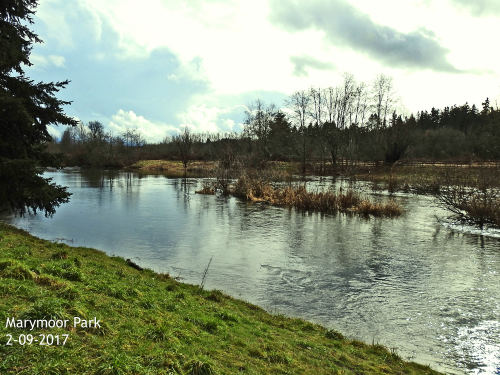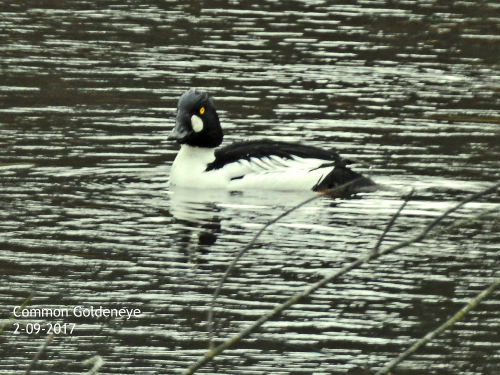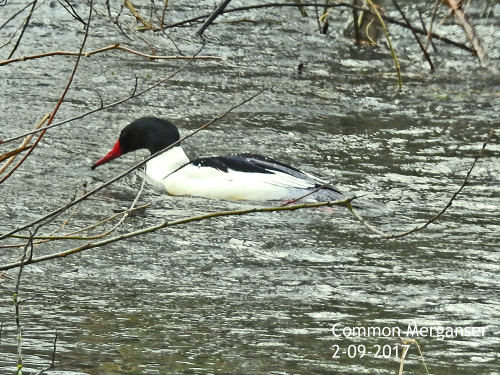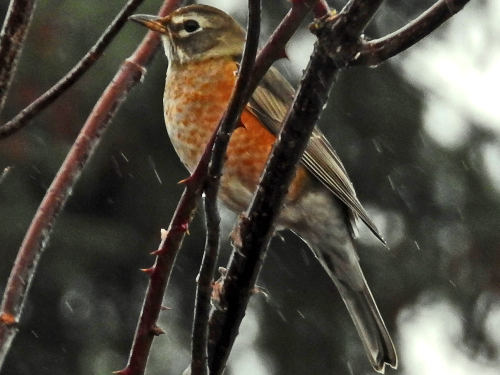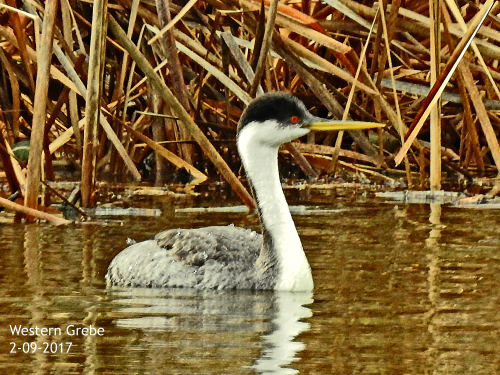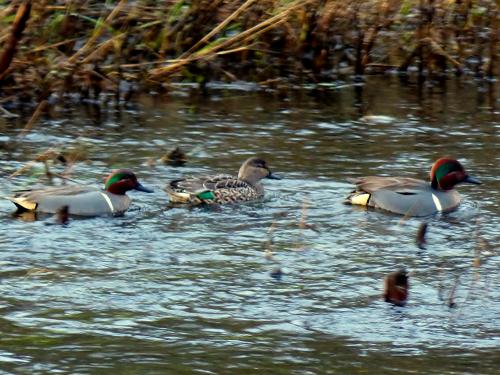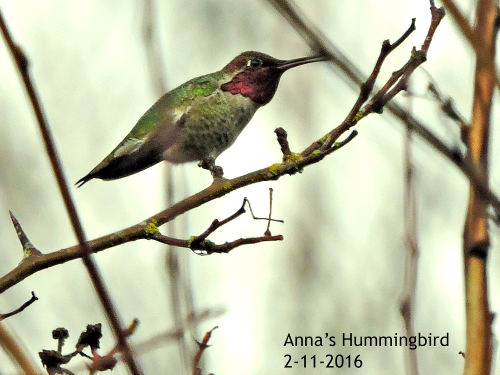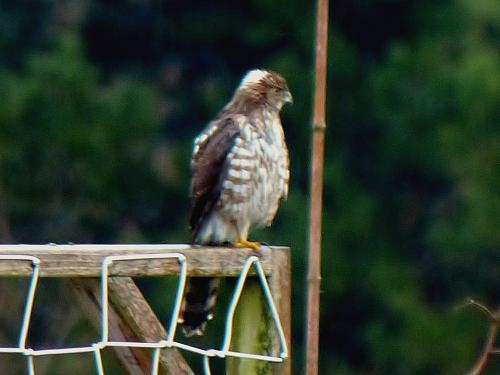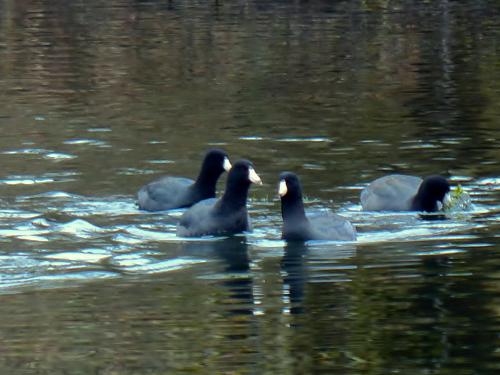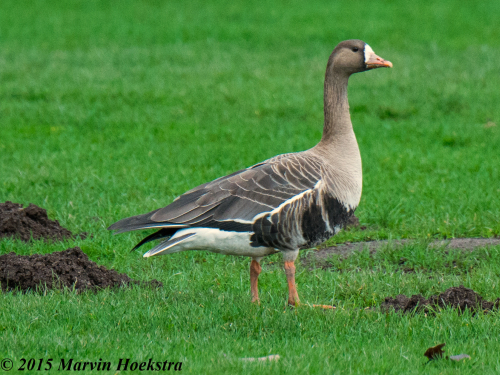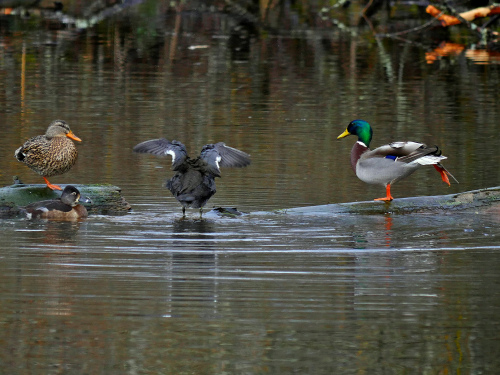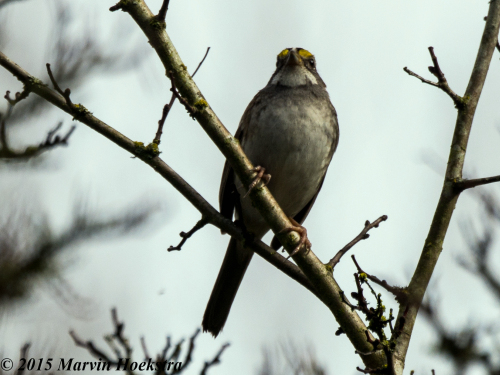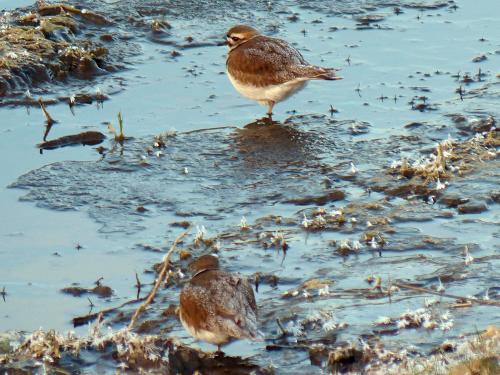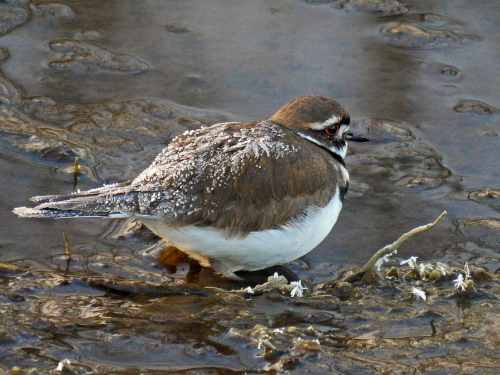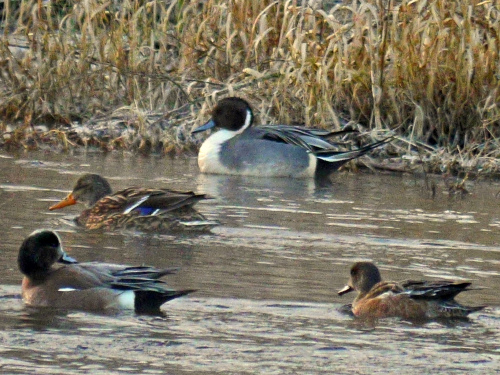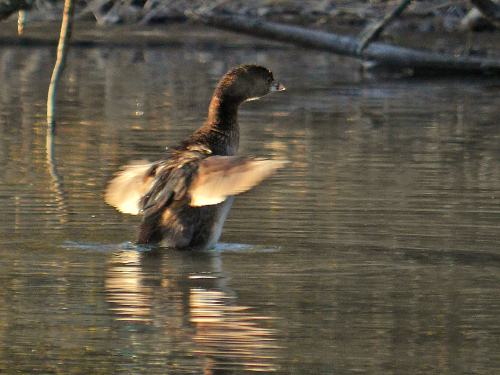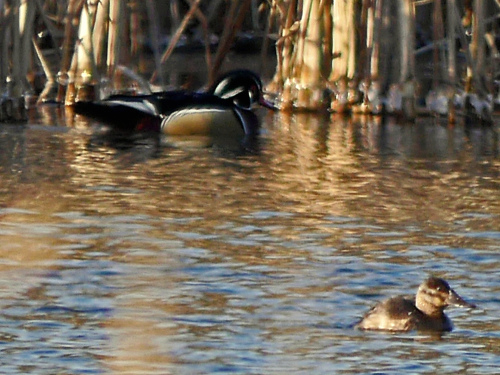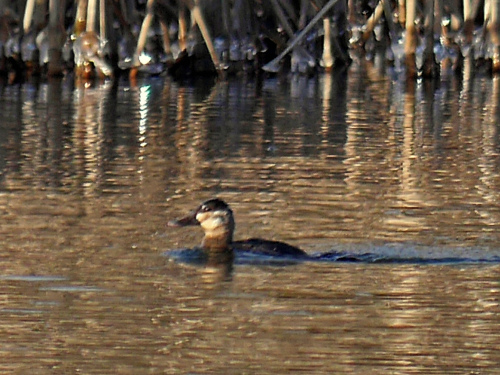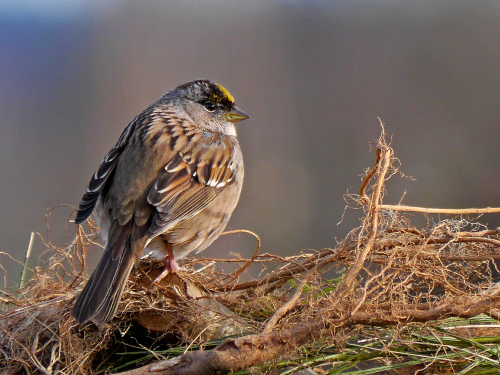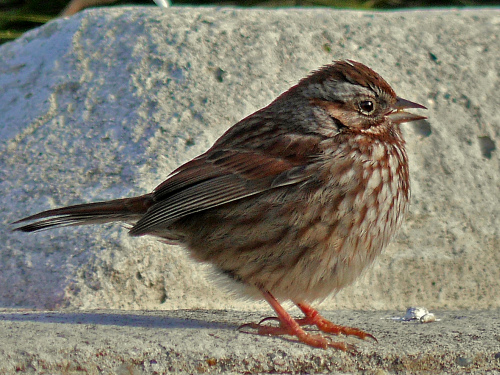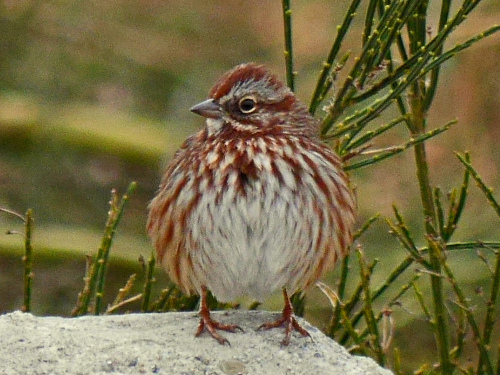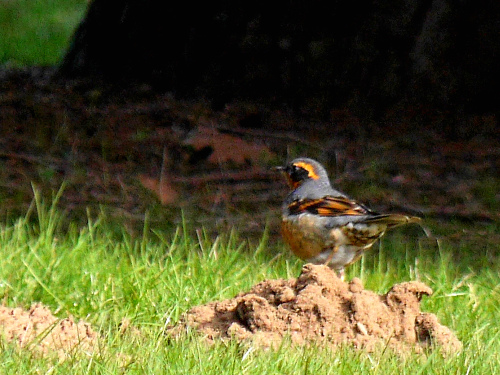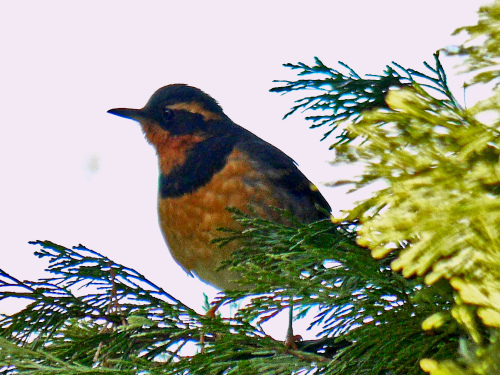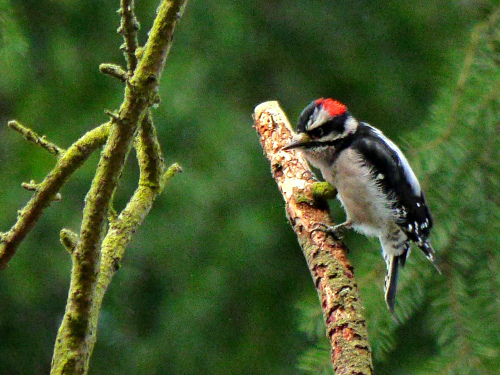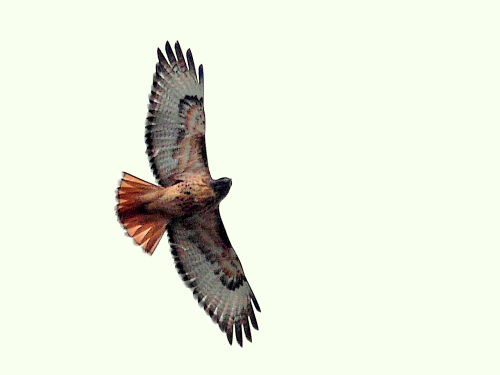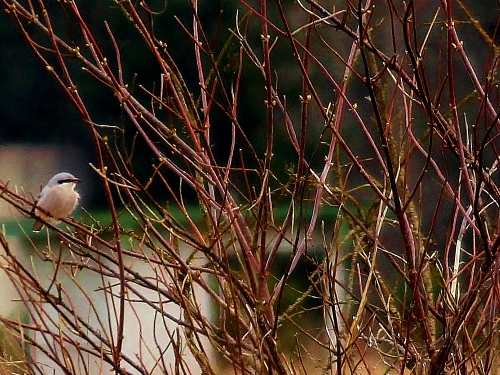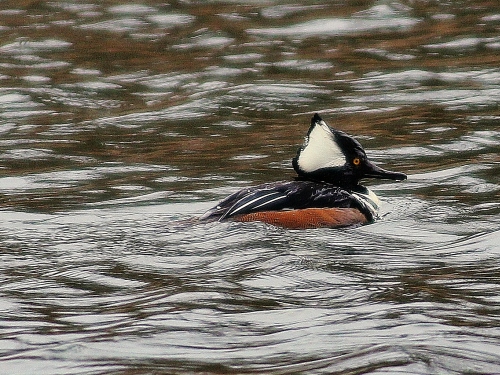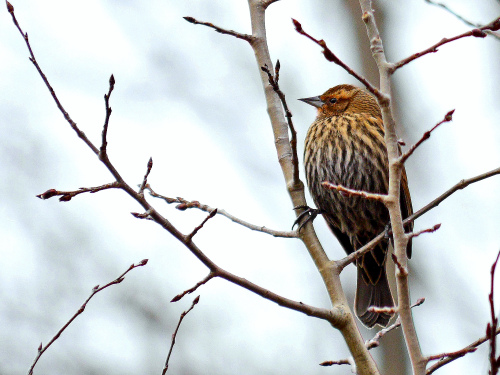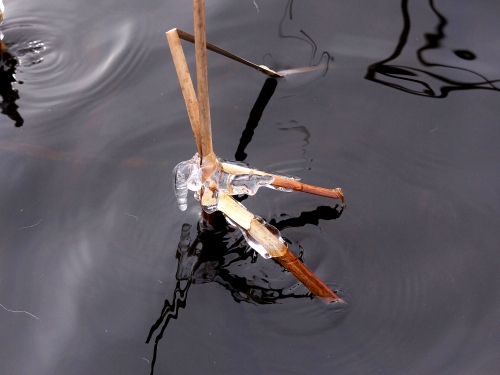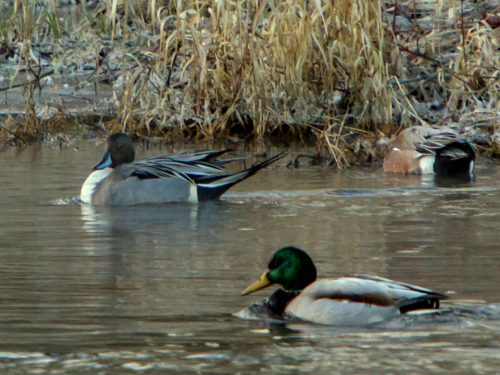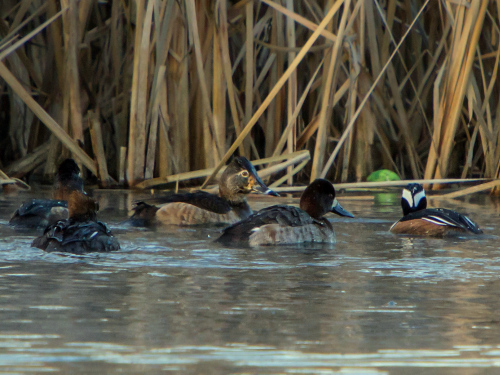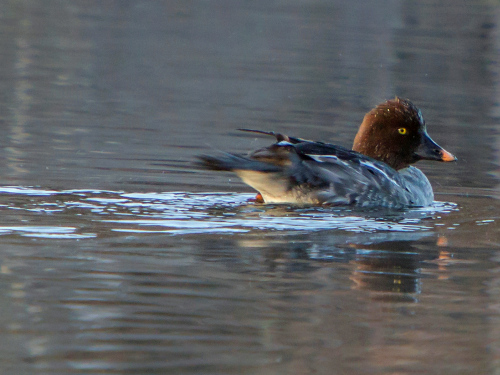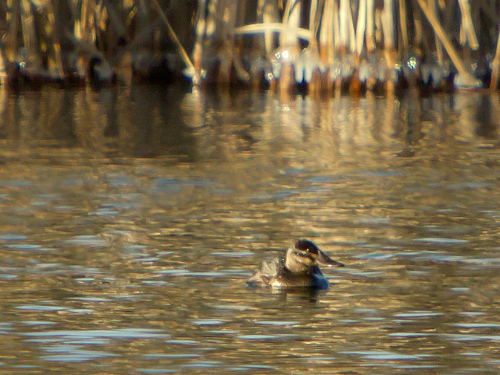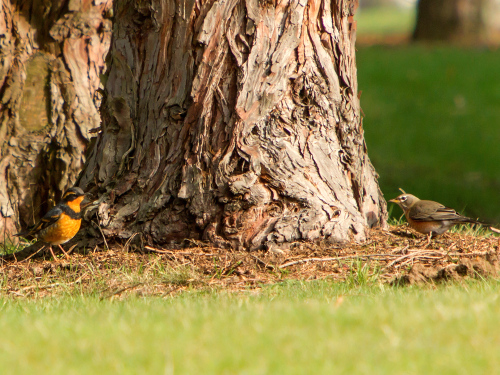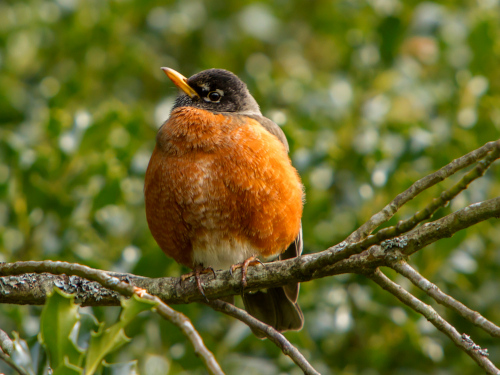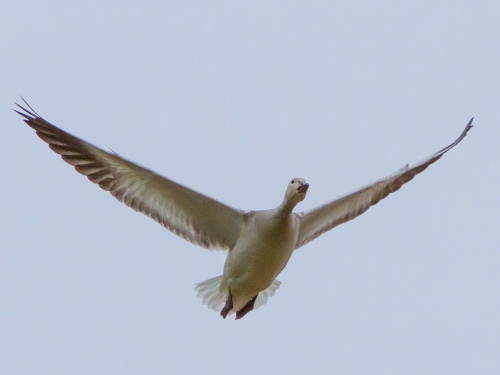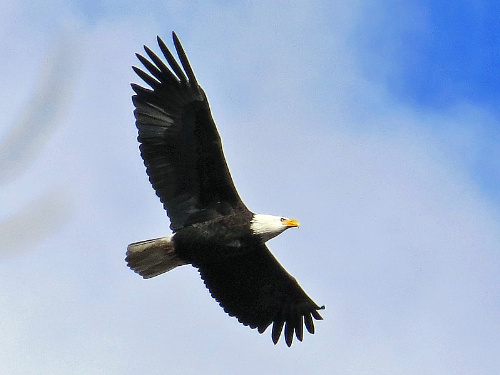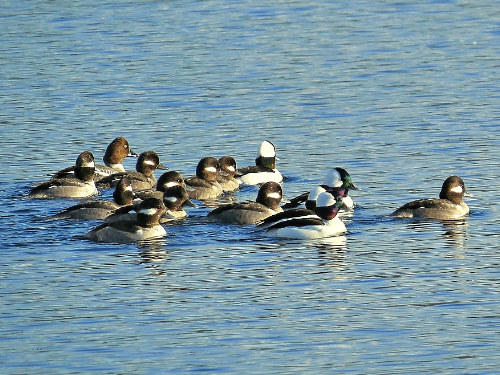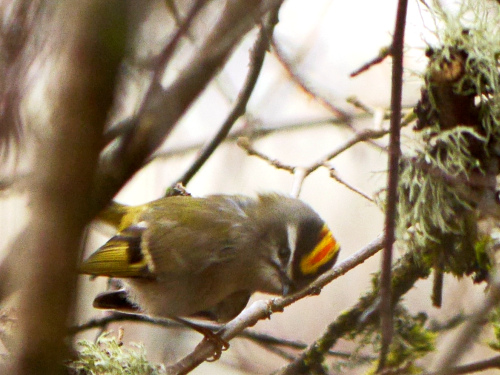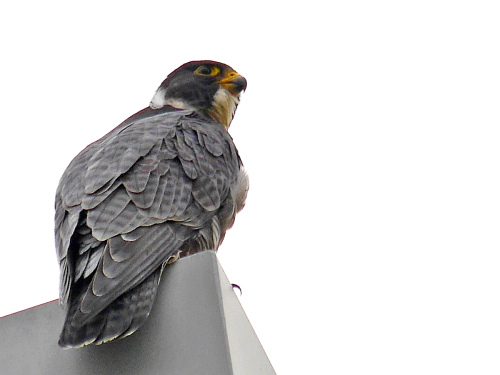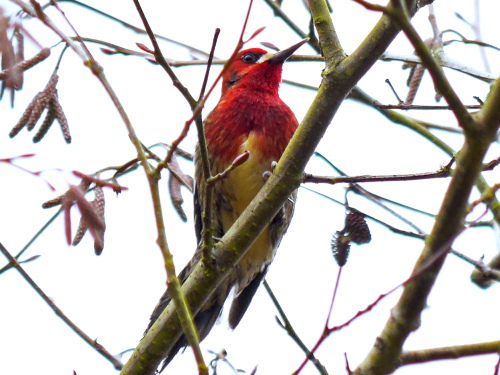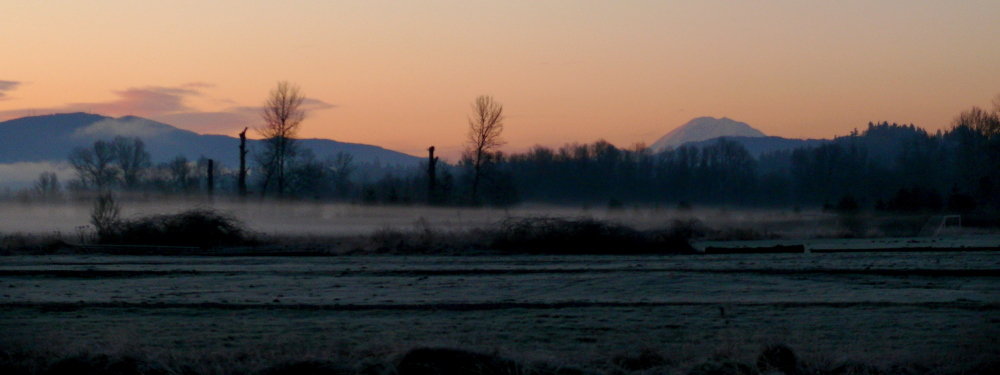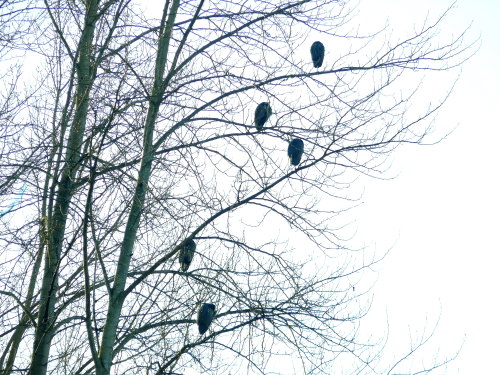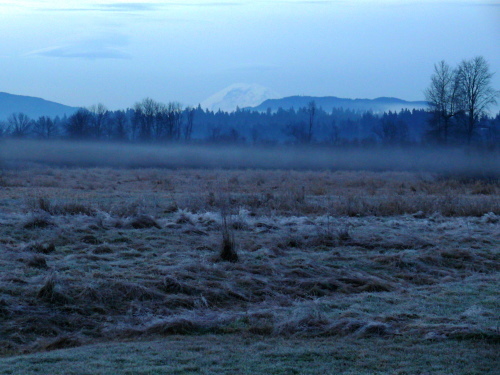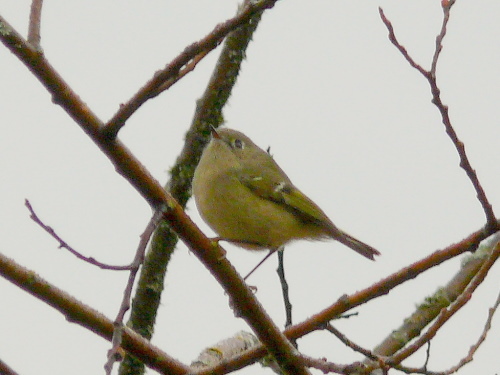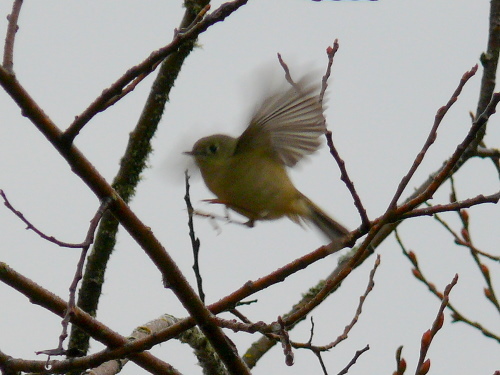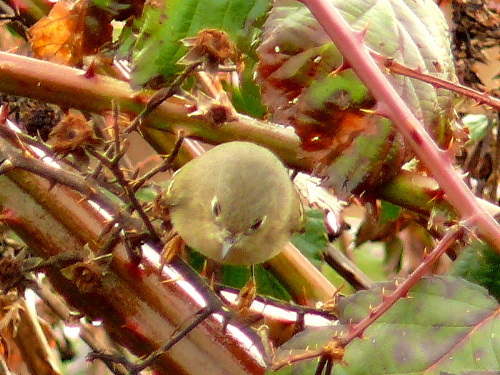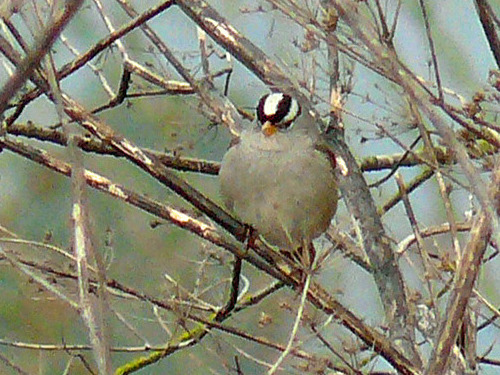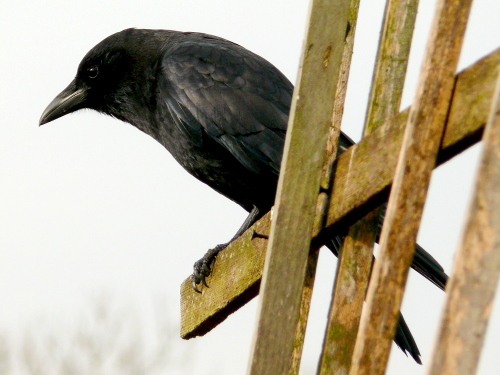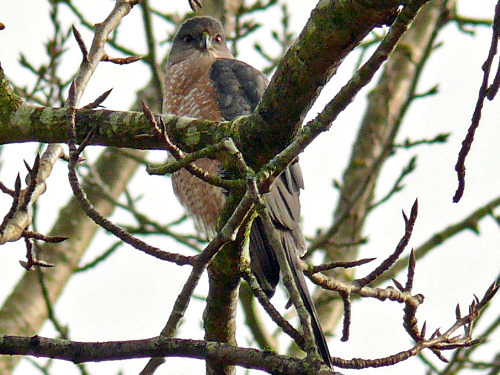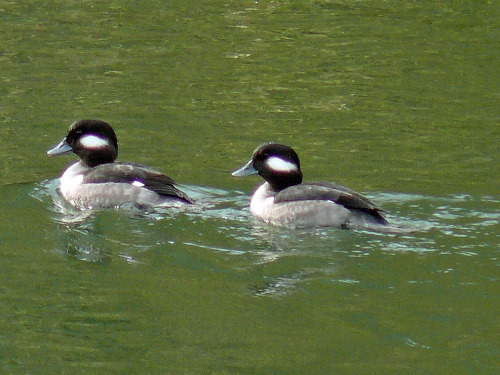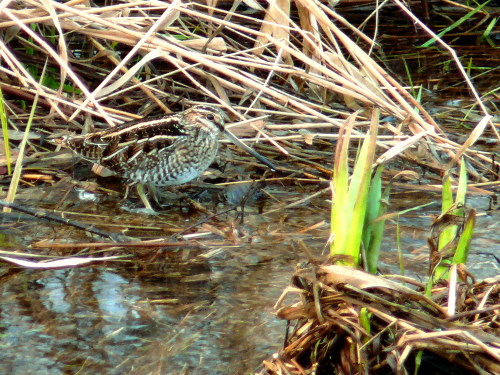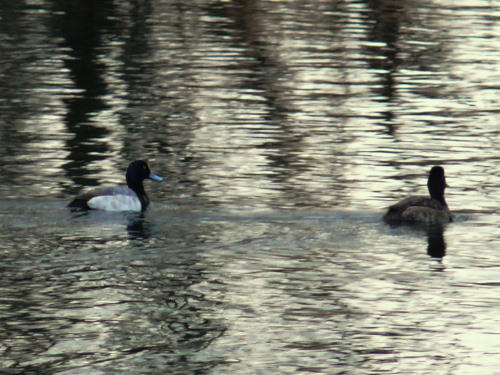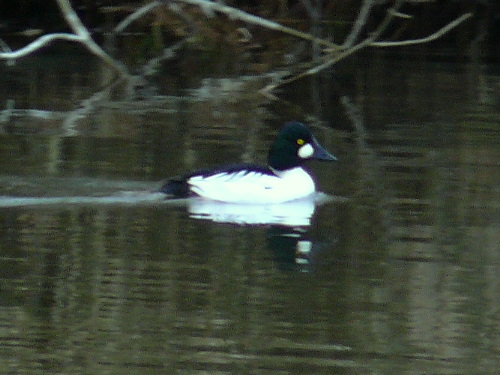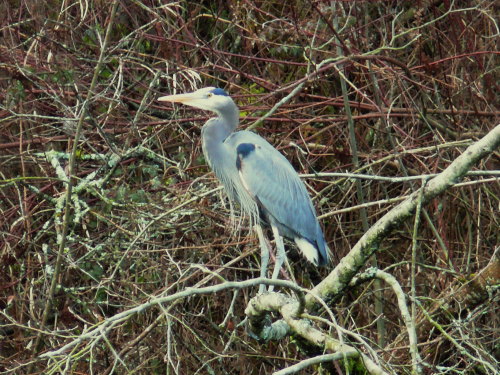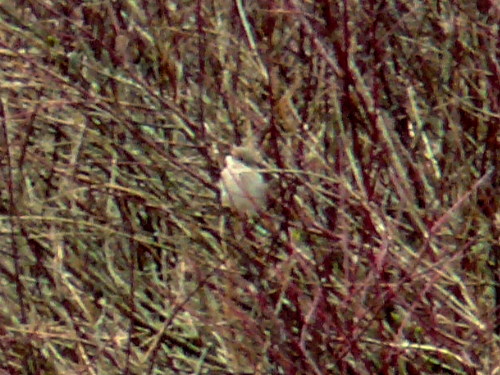Prev |
Bird Sightings Week 6
|
Next |
Rarities for Week 6:
| Barrow's Goldeneye | 08-Feb-07 | |
| Iceland Gull (L. g. thayeri) | 11-Feb-16 | |
|
...American Tree Sparrow |
05-Feb-09 |
Report for February 6, 2025 Birding at Marymoor
| The morning was covered in snow, though not very deep. It varied from 0.5" to a max of about 2", but it was clinging to everything in the 32 degree weather. It cleared very soon after sunrise, and we had a very pleasant day with no wind and a few moments of sunshine. Birdwise, it was varied, with long stretches of not much at all, but occasional good stuff. Highlights:
A late scan of the lake turned up our only RING-NECKED DUCKS and confirmed HORNED GREBE. The surprise was 5 TRUMPETER SWANS just off the Lake Platform (FOY) The HUTTON'S VIREO was just our 5th sighting ever for February. We have one December record, and no sightings at all for January. But Hutton's isn't common at Marymoor, with fewer than 50 records over the last 30 years. Near Dog Central, we faced a problem I've never had to deal with before. There was a whole flock of GOLDEN-CROWNED SPARROWS foraging from the ground, all the way up the trunks to the crown of large Cottonwoods. They were everywhere. And a BROWN CREEPER was singing. I've never been faced with trying to find the Creeper amongst the numerous Golden-crowned Sparrows that were probing the moss on the trunks and branches! Misses today were notable, including Green-winged Teal (after 45+ each of the last 2 weeks), Virginia Rail, Short-billed Gull, Ring-billed Gull, Bushtit (still none for us in 2025). We also had no Cackling Geese, owls, Northern Shrike, or Pine Siskin. For the day, though, we had 57 species, with 4 new for the year, putting us at 72 species in 2025. = Michael Hobbs |
|
|
|
Coyote in the East Meadow. Photo by Michael Hobbs |
Report for February 8, 2023 Birding at Marymoor
| A pleasant morning at the park, with temps in the low 40's, and only a touch of mizzle for a few minutes. Highlights:
River Otters were in the slough (FOY). A late scan of the lake was very successful, adding 5 species for the day. A female BELTED KINGFISHER was atop the beaver lodge across from the Lake Platform. Also near there were a pair of HOODED MERGANSER. Just beyond the buoys was a shining male GREATER SCAUP (FOY). COMMON MERGANSERS and RING-NECKED DUCKS were off to the east. Notable misses today were limited to just Marsh Wren and White-crowned Sparrow. For the day, 55 species, and we're at 68 species for 2024. = Michael Hobbs |
|
|
|
|
Report for February 9, 2023 Birding at Marymoor
|
We had a great day at Marymoor, with ridiculously good weather. Temps were in the high 40's, no wind, thin high overcast, essentially no precipitation (about two dozen drops per person, spread out over time). It was birdy too. Most of the birds were the expected ones, but we did have some nice surprises too.
Highlights:
We also had RIVER OTTER on the far side of the slough, and a RACCOON (FOY) high up in a cottonwood near the east end of the boardwalk
For the day, 54 species. = Michael Hobbs |
|
|
|
|
Report for February 10, 2022 Birding at Marymoor
|
We had a misty moisty morning today, with only a brief clearing mid-morning but mostly a lot of gray. Not terribly birdy, and there were long stretches with virtually nothing seen or heard. But the relatively warm temps, the moderately dry conditions, and the low wind allowed us to track down a few birds.
Highlights:
We also had 5 RIVER OTTERS seen from the Lake Platform in the slough, and our first turtles of the year – one each of Red-eared Slider and Painted Turtle at the Rowing Club.
The biggest highlight today was the number of species SINGING: Anna’s Hummingbird, Black-capped Chickadee, Marsh Wren, Bewick’s Wren, American Robin, Dark-eyed Junco, Song Sparrow, WESTERN MEADOWLARK, and Red-winged Blackbird. The Great Blue Herons were hanging around actually in the heronry trees (V – Visiting Nest Site).
Misses today included American Wigeon, Virginia Rail, Cooper’s Hawk, Northern Shrike, Red-breasted Nuthatch, Brown Creeper, Purple Finch, and Pine Siskin.
Despite that long list of misses, we managed 56 species. More than usual were detected by only 1 or 2 people and/or were heard-only, however. Still, not a bad day.
= Michael Hobbs
|
Report for February 11, 2021 Birding at Marymoor
|
It wasn’t too cold, and it wasn’t too windy, and we only had a dozen snowflakes this morning, under a high blanket of clouds. It was pretty birdy at times, though this being February, there wasn’t really anything unexpected.
Highlights:
With today’s sighting of CEDAR WAXWING for Week 6, we’ve now seen them during each week of the year, at least once over the last 25 years.
The only notable misses were Hooded Merganser and Northern Shrike.
A late scan of the lake turned up about 4 SCAUP spp., 2 COMMON MERGANSER, and a single RING-BILLED GULL. These late additions brought our day’s total to 63 species! But nothing was new for the year.
= Michael Hobbs
|
Report for February 6, 2020 Birding at Marymoor
|
A bit of an understatement to say it was damp at the park today. Lake Sammamish is now at about 29.4 feet lake level. At 28 feet, we start to see notable flooding at the park. Anything over 29 feet is major flooding. Water levels were so high that we were unable to get even within view of either end of the boardwalk, and thus had no looks at the lake at all. We had to skip the whole south end of the park.
But there were plenty of “lakes”, such as the flooding that filled the center portion of the Dog Area, and the large pond at the NE corner of the grass soccer fields. Lots of room for ducks, and they were spread thinly but widely. But few little birds, especially in the steady rain, despite the warm and windless conditions.
Highlights:
This is our first BROWN-HEADED COWBIRD for January, February, or the first half of March (and we’ve only had ten March sightings total). In Fall, we’ve only had four September, one November and one December sighting. So a very unusual sighting today. Possibly the bird was flooded out of whatever agricultural land it had been wintering on.
We did hear 9 species singing today, including BROWN CREEPER and GOLDEN-CROWNED KINGLET.
Misses today included Ring-necked Duck, Hooded Merganser, Common Merganser, Virginia Rail, Northern Shrike, Marsh Wren, House Finch, and Purple Finch. WE HAD NO FINCHES. We also missed squirrel and bunny.
For the day, 46 species.
= Michael
|
Report for February 10, 2019 Birding at Marymoor
| It was bitterly cold, but sunny, when I arrived just after 8. Within an hour, clouds rolled in, and the temperature rose but stayed below freezing. Away from the slough, birding was very quiet. I quickly learned to look in any bare patches under trees, as that’s where the passerines were. In the first of those sunny bare patches was a SONG SPARROW puffed up spherically. It was asleep (which became apparent when it startled awake as I approached). In the second was an almost insensate BARRED OWL. It was almost certainly hypothermic and was very far gone. I didn’t really have anyway to help it, and I hoped that the bright sun would warm it. Unfortunately not; when I checked on it later, it had succumbed. I’m afraid many other birds have perished in the cold overnight.
Highlights:
For the day, 61 species, including seven species not seen last Thursday. For the year, adding Northern Shoveler and Barred Owl, we’re at 81 species. == Michael Hobbs |
|
|
|
|
|
|
|
Report for February 7, 2019 Birding at Marymoor
| What a difference a week makes. Last week was spring, this week was the deepest depths of winter. Temps were in the upper teens to start, but with the sun and lack of wind, it did warm up to about the freeze by the time we were done. It was a gorgeous day, and very birdy.
Highlights:
It’s very clear that frozen water and fields in the Sammamish and Snohomish valleys have pushed ducks down to Lake Sammamish and the slough! A late scan of the lake added HORNED GREBE, a very distant LOON, MEW GULL, and the RIVER OTTERS we’ve seen every week this year so far. Also, an most interesting, was a AMERICAN x EURASIAN HYBRID WIGEON, something never noted at Marymoor before, to my knowledge. The head was rufous with a buffy forehead like a Eurasian Wigeon, but the body was not gray, but rather brownish like that of an American Wigeon. Some birds were singing, despite the cold. These included Anna’s Hummingbird, Black-capped Chickadee, Bewick’s Wren, House Finch, Purple Finch, Pine Siskin, Dark-eyed Junco, and Red-winged Blackbird. Spring is still happening, an a frozen way. Misses included Virginia Rail, Ring-billed Gull, Northern Shrike, Bushtit, and Marsh Wren. For the day, 63 species + the wigeon hybrid. For the year, adding 9 species, we’re up to at least 79 species. = Michael |
|
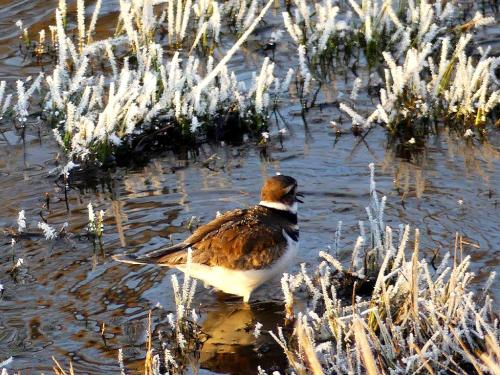 Frosty Killdeer in the slough. Photo by Hugh Jennings |
 Male Hooded Merganser. Photo by Hugh Jennings |
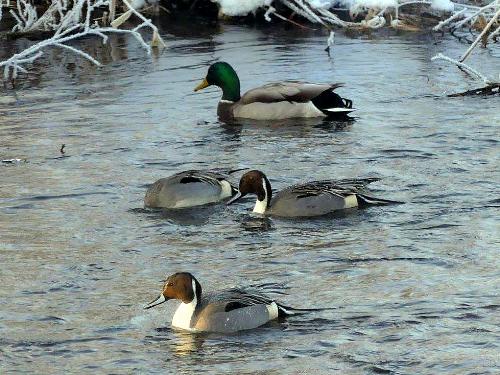 Northern Pintails with Mallard. Photo by Hugh Jennings |
 Male Northern Pintail. Photo by Bob Asanoma |
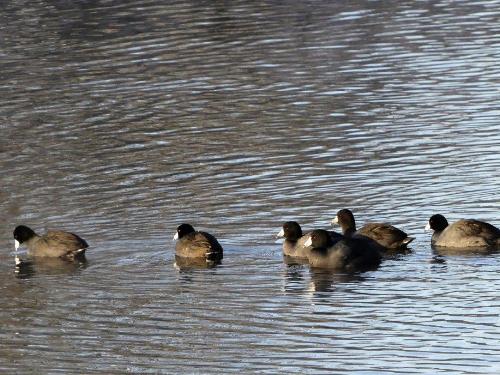 American Coots. Photo by Hugh Jennings |
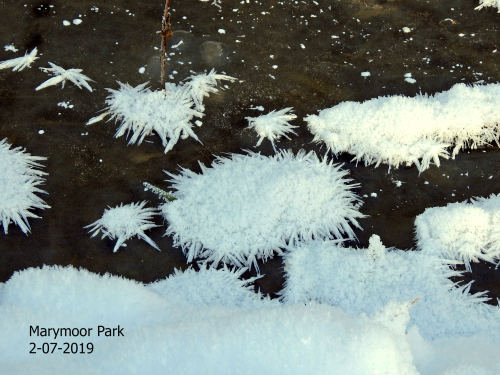 Photo by Bob Asanoma |
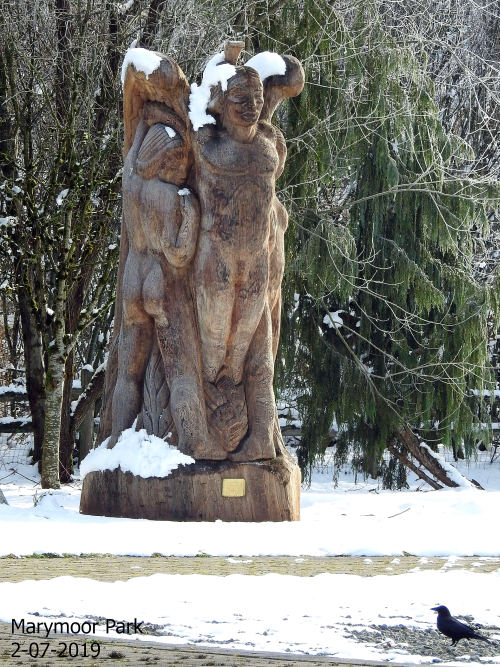 American Crow. Photo by Bob Asanoma |
 Sharp-shinned Hawk. Photo by Bob Asanoma |
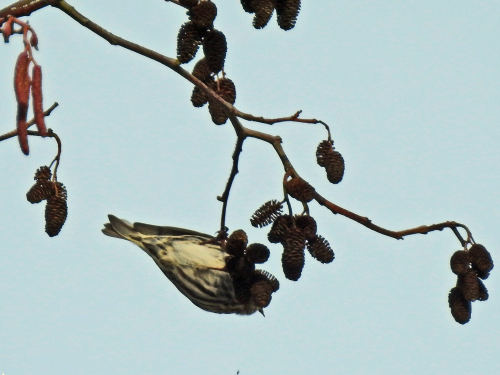 Pine Siskin. Photo by Bob Asanoma |
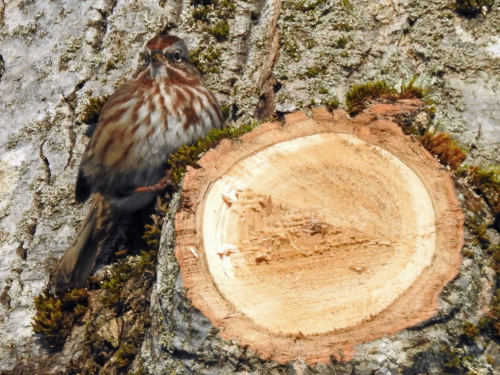 Song Sparrow. Photo by Bob Asanoma |
Report for February 8, 2018 Birding at Marymoor
| The good news was that it was warm (51+) and not raining; we got only a few minutes of breeze-blown mist, and the rest of the morning was dry. There was a bit of breeze when we were out in the open, especially atop the Viewing Mound, but the lake was pretty calm. It was darkly overcast, however. It was also VERY quiet, with low numbers of most species, and our lowest species count yet for 2018.
Highlights:
Anna’s Hummingbird, Brown Creeper, Bewick’s Wren, Spotted Towhee, Song Sparrow, Dark-eyed Junco, and Red-winged Blackbird were heard singing today. Misses today included Ring-necked Duck, Steller’s Jay, Bushtit, and House Finch – a short list considering how few species we had today. But the 2nd week in February has our second lowest cumulative number of species seen, beating out only the last week in January, 96 vs. 94, so a short list is to be expected now. For the day, we did manage 48 species, with two new ones (PEFA and YRWA) to bring the 2018 list to 73. Oh, and at the Rowing Club pond, we had our first turtle of the year, a Red-eared Slider. == Michael Hobbs |
|
|
|
|
|
|
|
Report for February 9, 2017 Birding at Marymoor
| “Après moi, le deluge.” Apparently, the old french guy visited last night, because it was pretty much a deluge this morning. And three of us definitely show all the signs of compulsive behavior, because I was joined by Brian Bell and Matt Bartels joined me. Everyone else managed to find somewhere else to be...
Unsurprisingly, birds were scarce, but we were not totally bereft of sightings. And the morning was not too cold, and the wind and thunder held off until after the walk, so things really weren’t that bad. Except for being really, really wet. Most notable was seeing all of the damage from Monday’s snow. Small deciduous trees and shrubs were especially hard hit. Fruit trees were hammered, and we lost many alders and willows as well. Large deciduous trees, and conifers, appeared only to have lost a limb or two. Bird highlights: - 8 species of duck - For the day, we managed 46 species, which I feel is pretty good. == Michael Hobbs |
|
|
|
|
|
|
|
Report for February 11, 2016 Birding at Marymoor
| A really nice start to the morning, with warmth, sunshine, and birds. Slowly the weather deteriorated, but only got as bad as overcast with a few sprinkles. The birds got a lot quieter though.
Highlights: Wood Duck Handsome male in slough, first since Week 1 There were at least 30 GREAT BLUE HERONS in a cottonwood 100 feet north of the heronry. At least 1 bird was flying around with a stick as if to demonstrate his abilities. Five birds were seen at the heronry, including 2-3 standing on nests. The ORANGE-CROWNED WARBLER was quite a surprise. This is our first February sighting ever. We’ve only had 1-2 sightings ever in January, and 3 for December. We’ve had about a sighting or two each week in March, but they are not commonly at Marymoor before April. The bird was cooperative as it hopped around the wall of blackberries, acting like a Ruby-crowned Kinglet, quite close to us. One species we did not have today, nor have we had for several weeks, is Barn Owl. They have been conspicuously and unexpectedly absent from the meadows visible from the Viewing Mound in the pre-dawn hours. Last week, we did find quite a few Barn Owl pellets under the cedars next to the windmill though. For the day, 55 species. For the year, adding "THAYER’S" ICELAND GULL, PILEATED WOODPECKER, and ORANGE-CROWNED WARBLER, we’re up to 73 species for the year. == Michael Hobbs |
|
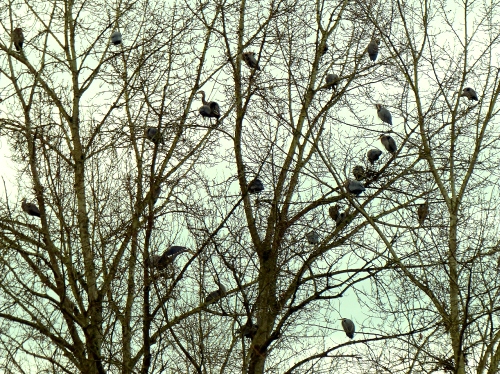 Great Blue Herons in tree 100 yards north of heronry. Photo by Hugh Jennings |
 Great Blue Heron on nest in heronry. Photo by Hugh Jennings |
Report for February 5, 2015 Birding at Marymoor
| Yeah, yeah. It rained. Just as promised, it was dark and rainy. That said, there was an awful lot of time this morning when it wasn’t raining, and for about a half hour, we even had some sun. Well, for part of that sunshine period, it rained, BUT HEY! It was a good day for February, and Spring definitely feels like it is arriving. Most of our resident birds were singing, though of course it’s still too early for Spring arrivals.
Highlights: (FOY – First of Year) Greater White-fronted Goose Adult in flock of late-arriving Cacklers Pretty much everything else were the expected birds, but we had very few “misses” today. We had 3 species of goose, and 10 species of duck. Matt and the early gang had NO OWLS today, but Grace&Ollie had 2 NORTHERN SAW-WHET OWLS and heard a GREAT HORNED OWL (FOY) on Saturday, 2015-01-31. Singing birds included BLACK-CAPPED CHICKADEE, BROWN CREEPER, MARSH WREN, BEWICK’S WREN, RUBY-CROWNED KINGLET, AMERICAN ROBIN, SONG SPARROW, and DARK-EYED JUNCO. For the day 57 species. For the year, adding GHOW and WTSP puts us at 76 species. == Michael Hobbs |
|
|
|
|
|
|
|
Report for February 6, 2014 Birding at Marymoor
| A bit of background here: I did the Wenatchee CBC this winter, and was assigned as my sector the Horan Wildlife Area and about six square blocks of downtown that were mostly filled with warehouses. All in all, it was about a quarter of a square mile, and I spent the whole day walking around birding there. One thing I noticed was that some species came into the sector as dusk approached. I found quite a few species after lunch that we didn’t find before lunch, even though I was birding the same set of trails and roads.
So I decided I should try the same thing at Marymoor sometime, and the first reasonable “sometime” was today. Three of us arrived before 6:30, and the rest arrived at 7:30. We birded until a little before noon, went out to lunch at Panera, then came back for another couple of hours. By that time everybody was cold, tired, and had the feeling there were few additional species to find, so we went home. But I returned for another go from 5:00 to 6:00. The morning was frigid, with the temperature at 15 degrees at 6:00 a.m., remaining at that temp when we started at 7:30. It rose all the way to 31 degrees when we broke for lunch, but by then the wind had picked up and the sky clouded over, so it chilled us quite thoroughly. The temperature quickly dropped back to 29 degrees. The pre-dawn owling produced a heard-only VIRGINIA RAIL for Matt, and nothing else. But once we started the regular walk, it was clear it was going to be a good day. The slough was filled with waterfowl. We did our regular walk in the regular fashion. After lunch, we walked the East Lake Sammamish Trail along the east edge of Marymoor, walked the Marymoor Connector Trail from the model airplane field east to the ELS Trail, and then we made a brief stop at the Viewing Mound again. From 5-6 p.m., I came back and did a quick loop from the East Kiosk around the boardwalk and back. We never did get to the area west of the slough and north of the Rowing Club that I had hoped to include today. Highlights: (FOY – First of Year) Greater White-fronted Goose 1 adult with huge flock of Cacklers We had 52 species by lunchtime, which is an unusually good total for February. We added 7 more species during the after-lunch birding. When I arrived at 5:00 p.m., I was able to find a couple of PACIFIC WRENS in the Big Cottonwood Forest, which had been one of our biggest misses previously. As I walked the boardwalk, I heard a couple of VIRGINIA RAILS calling from the same area that Matt had heard one pre-dawn. Then, as I went north from the east end of the boardwalk, I heard a GREAT HORNED OWL (FOY) calling. This was at 5:30. I went back via the grass soccer fields, where the huge flock of geese remained until 5:55 p.m. (almost full dark), when the finally took off and flew towards the lake all in a tight, no-nonsense flock. Standing on the Viewing Mound until 6:00 p.m., I could hear the GREAT HORNED OWL move closer and closer to the southeast, but I never saw the bird. So, we were out for about nine hours total, across about 13 hours of the day. We managed 61 species total - not bad for February in a single square mile. Three species were seen in Week 6 for the first time in the 20 years of my surveys: Wood Duck, Northern Pintail, and Ruddy Duck. Our only notable misses for the day were Bushtit, White-crowned Sparrow, Purple Finch, Pine Siskin, and House Sparrow, all of which have been seen 10 or more times in Week 6 during the last 20 years. Of those, though, only Bushtit has been seen regularly this winter. I was speculating that maybe the Bushtits were spending the day huddled together for warmth in some kind of sheltered spot. In addition to the four species marked First of Year (FOY) above, this was the first time this year that Snow Goose had been seen on a Thursday survey. This brings our year total to 74 species. Five additional species are listed ebird (Lesser Scaup, Herring Gull, "Thayer’s" Iceland Gull, Short-eared Owl, and Common Raven). 61 of the 79 species seen so far this year seems an excellent day. Three new species for our Week 6 list (cumulative, over the last 20 years), brings the Week 6 list to 91 species. Week 26 (the last week in June) is now the worst week, at only 89 species. Maybe we’ll have to do another Marymoor Long Day that week to bring its total up to par. Thanks to all of the devoted crew who made this a really fun Long Day, despite the chill. == Michael Hobbs |
|
|
|
|
|
|
|
|
|
|
|
|
|
|
|
|
|
|
|
|
|
|
|
|
|
|
|
|
|
|
|
|
|
|
|
|
|
|
|
|
Report for February 7, 2013 Birding at Marymoor
| The pre-dawn stiff breeze and sprinkles cleared to beautiful sunshine and warmth this morning; exceptionally nice weather for February. And, damning with faint praise, it was birdy for February too. Actually, the day was pretty good for birds as well as weather, though we didn’t have anything terribly noteworthy. For the first time this year, we had NO OWLS during our pre-dawn searching. That was disappointing.
Highlights: Green-winged Teal 5 pairs in Rowing Club Pond Singing birds included BROWN CREEPER, BEWICK’S WREN, SONG SPARROW, DARK-EYED JUNCO, and RED-WINGED BLACKBIRD. The Heronry was again filled with roosting GREAT BLUE HERONS, though there was no sign of nest work. We managed 55 species for the day, though nothing new for the year. == Michael Hobbs |
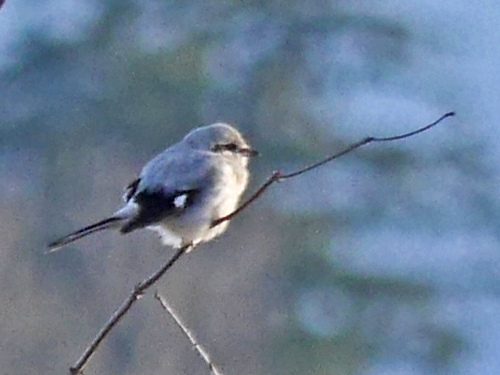 Northern Shrike. Photo by Ollie Oliver |
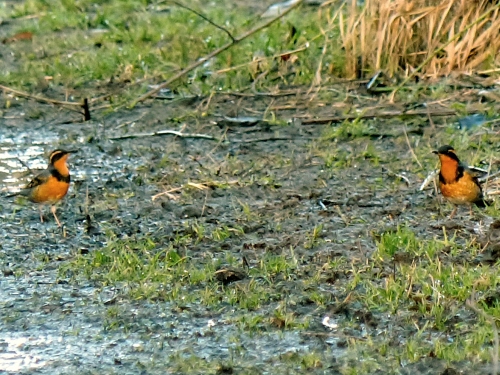 Two Varied Thrushes along the path near the weir. Photo by Hugh Jennings |
 Male Varied Thrush. Photo by Ollie Oliver |
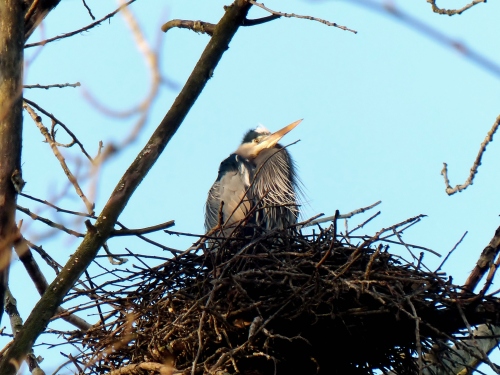 Great Blue Heron sitting on a nest. Photo by Hugh Jennings |
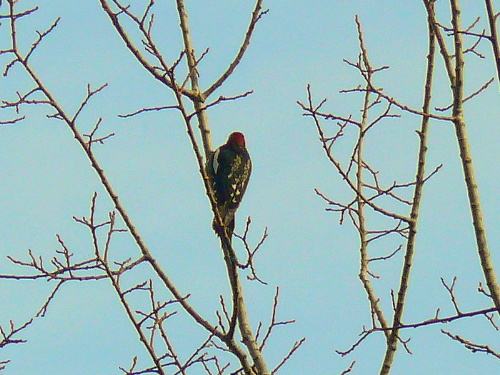 Red-breasted Sapsucker at the Rowing Club. Photo by Michael Hobbs |
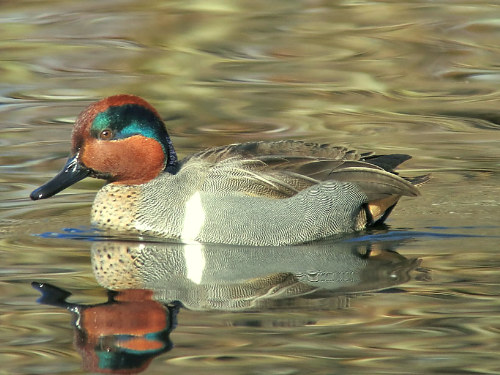 Male Green-winged Teal, Thursday afternoon. Photo by Mike Hamilton |
|
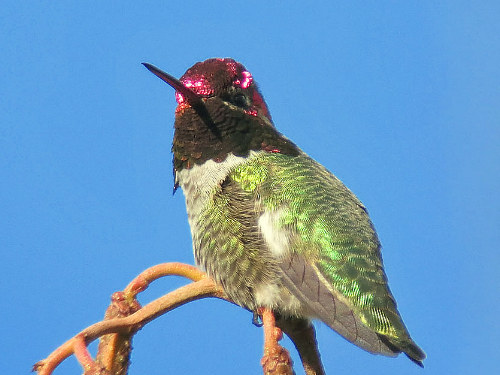 Male Anna's Hummingbird, Thursday afternoon. Photo by Mike Hamilton |
|
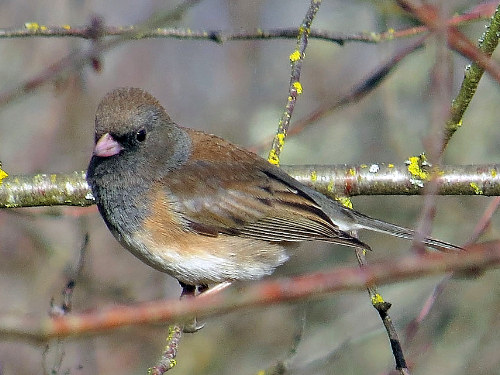 Dark-eyed Junco, Thursday afternoon. Photo by Mike Hamilton |
|
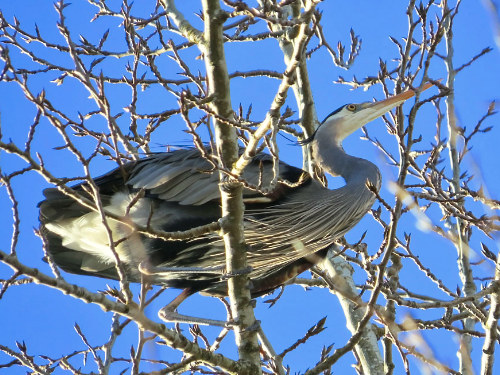 Great Blue Heron, Thursday afternoon. Photo by Mike Hamilton |
|
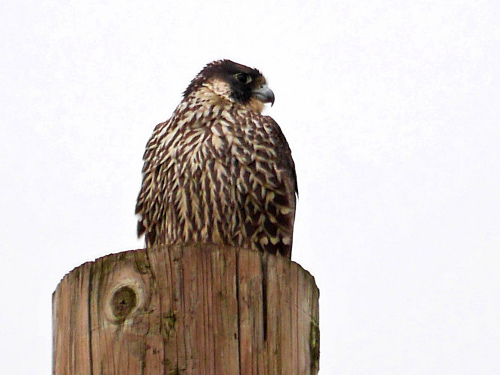 Juvenile Peregrine Falcon, 2013-02-06. Photo by Ollie Oliver |
|
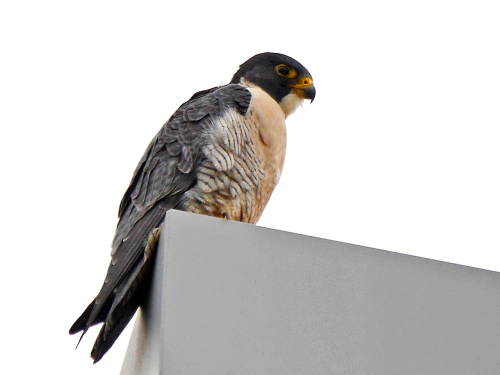 Adult Peregrine Falcon, 2013-02-06. Photo by Ollie Oliver |
|
Report for February 9, 2012 Birding at Marymoor
|
It was a great pre-dawn at Marymoor today. Unfortunately, I wasn't there for that. Matt & Scott had 3 species of owl - GREAT HORNED OWL near the windmill, BARRED OWL at the Rowing Club, and BARN OWL near the Cavalia tents. For the rest of us, the morning was merely a typical drizzly February day. |
|
 Male Anna's Hummingbird. Photo by Hugh Jennings |
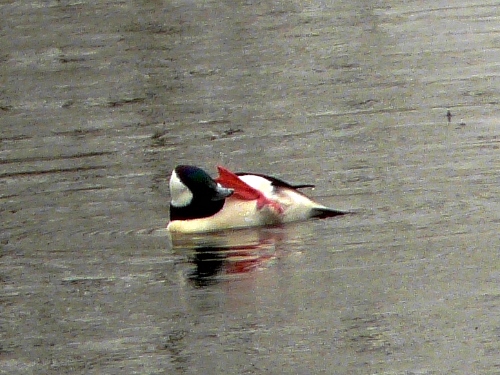 Male Bufflehead. Photo by Hugh Jennings |
Report for February 10, 2011 Birding at Marymoor
|
February typically has the lowest species counts of the year, and today was no exception, despite the glorious sunshine. It was only about 26 degrees when we started, though with the sun, it warmed to 43 before we were done. Plenty of birds were singing, including the first American Robin songs I've heard this year. But we had no accipiters, no falcons, only one species of gull, and no shorebirds. We also had nobody at the park early, and thus ended up with zero owls. Still, it was a nice walk. |
Uncredited photos by Michael Hobbs |
|
|
|
|
|
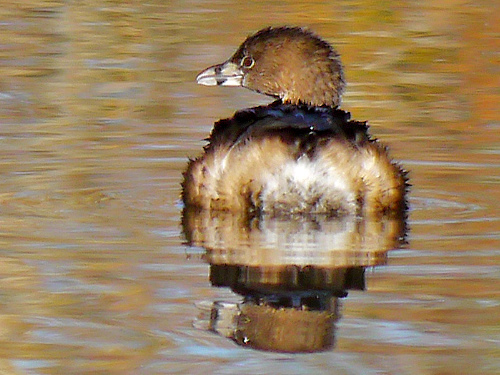 Pied-billed Grebe. Photo by Ollie Oliver |
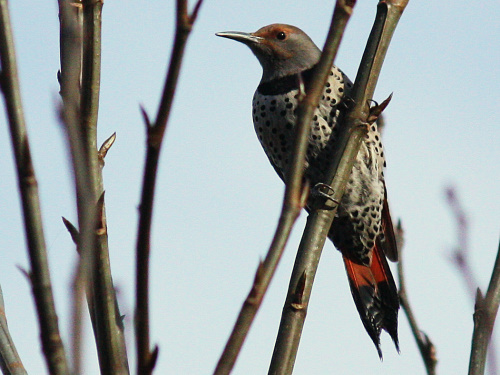 Female Northern Flicker. Photo by Lillian Reis |
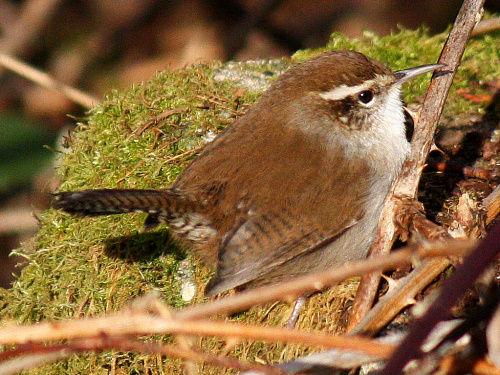 Bewick's Wren. Photo by Lillian Reis |
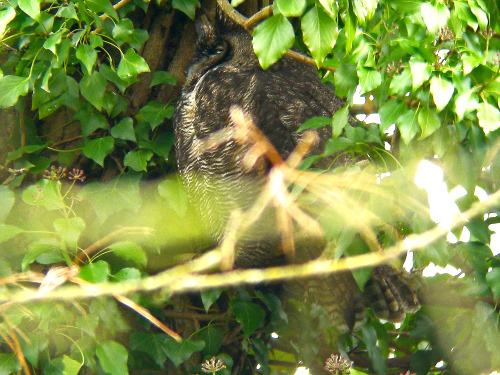 Great Horned Owl, 2011-02-06. Photo by Ollie Oliver |
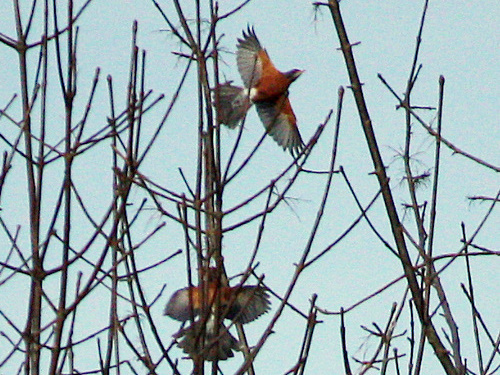 American Robins. Photo by Lillian Reis |
Report for February 11, 2010
|
Early rain and rain after, but except for the first half hour, we were blessed with another good day for birding at Marymoor. For a few minutes around 11:00, it was actually sunny, though most of the morning was rather dark, though warm. It certainly feels spring-like, though of course we still only have "winter" birds. |
 Beaver just upstream from the weir. Photo by Ollie Oliver 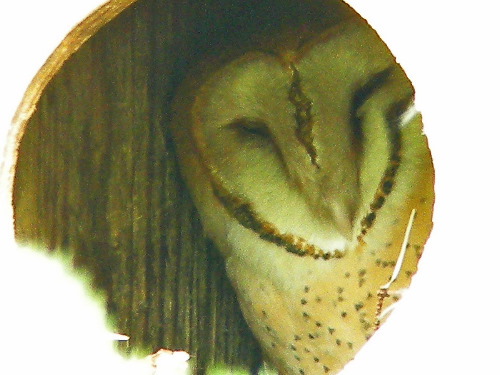 Barn Owl in the nest box between the mansion and the stage. Photo by Ollie Oliver |
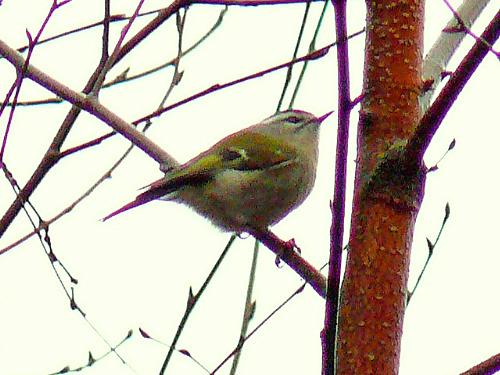 Golden-crowned Kinglet. Photo by Ollie Oliver |
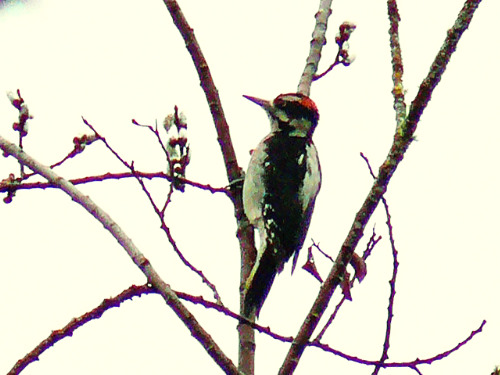 Hairy Woodpecker, uncharacteristically on a twig, not a trunk. Photo by Ollie Oliver |
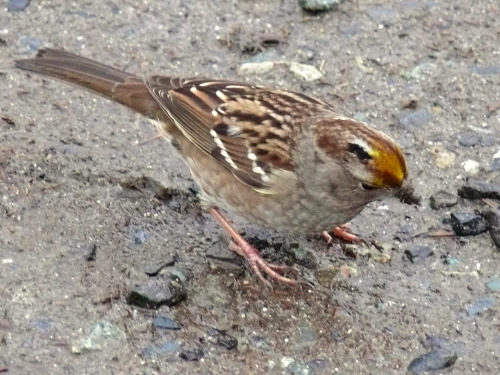 Golden-crowned Sparrow with odd black-and-white mark on one side of the head only. Photo by Ollie Oliver |
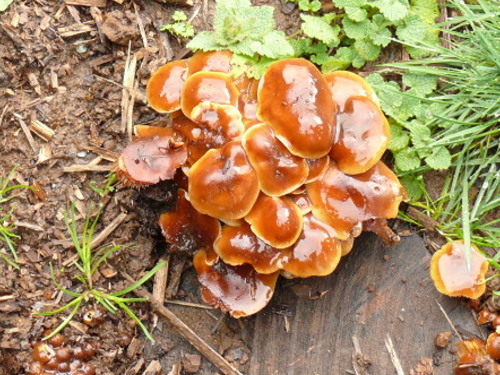 Fungus near the windmill |
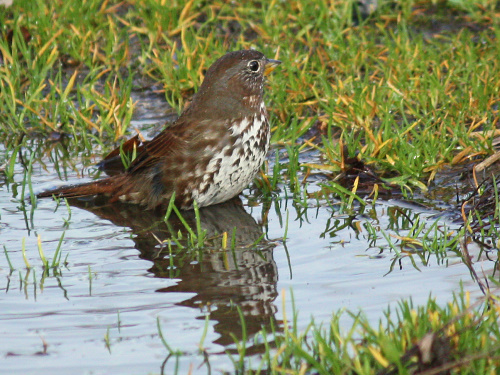 Lillian Reis had better weather for photographing this Fox Sparrow, 2010-02-05 |
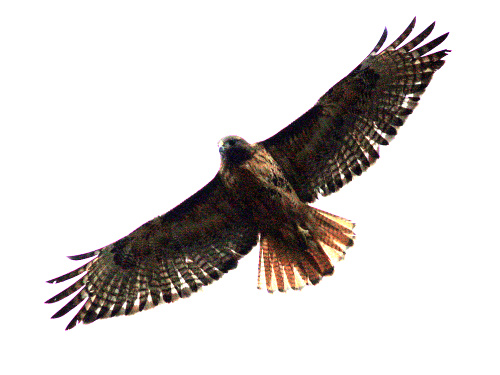 Lillian caught this Red-tailed Hawk imitating the cover of the big Sibley, 2010-02-12 |
Report for February 5, 2009
|
It was a pretty quiet day at Marymoor today - frosty, with high overcast, and some thin ground fog early. Not the warm spring day we had yesterday. There were very few birds that gave us good looks - much of what we did see was very distant. The AMERICAN TREE SPARROW remains active around the Compost Piles, even with road graders reworking the parking lot and a front-end loader pushing branches around the piles themselves. Other highlights: Bewick's Wren, American Robin, Dark-eyed Junco, Red-winged Blackbird, and House Finch all singing. I had a BARN OWL flying around the main park road at around 7:00. The male COOPER'S HAWK was seen in Snag Row several times. Had some good looks at PURPLE FINCH just south of Dog Central. DOWNY WOODPECKERS and RUBY-CROWNED KINGLETS also showed themselves well. We had a very distant look at the NORTHERN SHRIKE, today perched at the far side of the model airplane field. An ANNA'S HUMMINGBIRD was on one of his usual perches near the picnic shelter south of the windmill. Really, except for the ATSP, there wasn't much of note. Still, it beats sitting at home. OH - we did have a COYOTE at the southeast part of the East Meadow - our first for 2009. For the morning, 50 species. == Michael |
|
|
|
|
|
|
|
|
|
|
|
|
|
Report for February 7, 2008
|
I was expecting the worst, but we actually had a much better day than last week. Although windy, it often wasn't too windy (the wind often seemed to be passing above us), and it didn't rain, and it wasn't too cold. It was, in marked contrast to last week, rather birdy. Eleven of us had a pretty good time. Highlights: Matt and Scott had a pair of COYOTE over by the East Meadow pre-dawn. A WILSON'S SNIPE didn't flush, but instead gave us great looks for over a minute at pretty close range, below the weir. We had a very close encounter with a mixed flock of tiny birds - BLACK-CAPPED CHICKADEE, RUBY and GOLDEN-CROWNED KINGLETS, and BUSHTITS - well south of the East Meadow. The birds were often within just a few feet of us. An immature NORTHERN SHRIKE was vocalizing along the east edge of the East Meadow. The bird was very drab, and would have been missed if it hadn't been making a wide variety of squeaks. The pair of RED-TAILED HAWKS again shared a branch in a cottonwood east of the East Meadow. The Rowing Club featured a BROWN CREEPER and a RED-BREASTED SAPSUCKER, as well as a pair of GREEN-WINGED TEAL trying to be invisible on the far bank of the main pond. After the Rowing Club, I went back to the park office to buy my annual parking pass. In the tree above my car, an ANNA'S HUMMINGBIRD was calling. For the day, the Anna's made it an even 50 species. LESSER SCAUP and RED-BREASTED SAPSUCKER were new for 2008, bringing our year list to 72 species. == Michael |
|
|
|
|
|
|
|
Report for February 8, 2007
| Despite weather reports and the general appearance of the morning, we actually had a really nice day at Marymoor. It was warm (45-56 degrees), pretty much windless, and we had only a moment of not-even-drizzle. There were 11 of us birding, and (especially early on) it was quite birdy. There weren't too many surprises in terms of unusual species, but it was a good day nonetheless. Highlights: The BALD EAGLES were seen bringing sticks to the new nest in the Big Cottonwood Forest. Both adults were in the nest for a little while. We'd seen no activity there for a few weeks, so this was a nice confirmation that they seem intent on nesting in such a visible location. After the Rowing Club, I went over and walked the Redmond portion of the East Lake Sammamish Trail. There were two adult Bald Eagles hanging around in the SE corner of the park, even while I could see at least one of the pair from the SW corner. I was able to verify that the SE nest still exists, so it appears there will be two breeding pairs of Bald Eagle at Marymoor this year! The nests are only a half mile (maybe 0.6 miles) apart. Matt heard WILSON'S SNIPE predawn in the East Meadow, and we saw one flush from below the weir. |
Prev |
Bird Sightings Week 6
|
Next |
